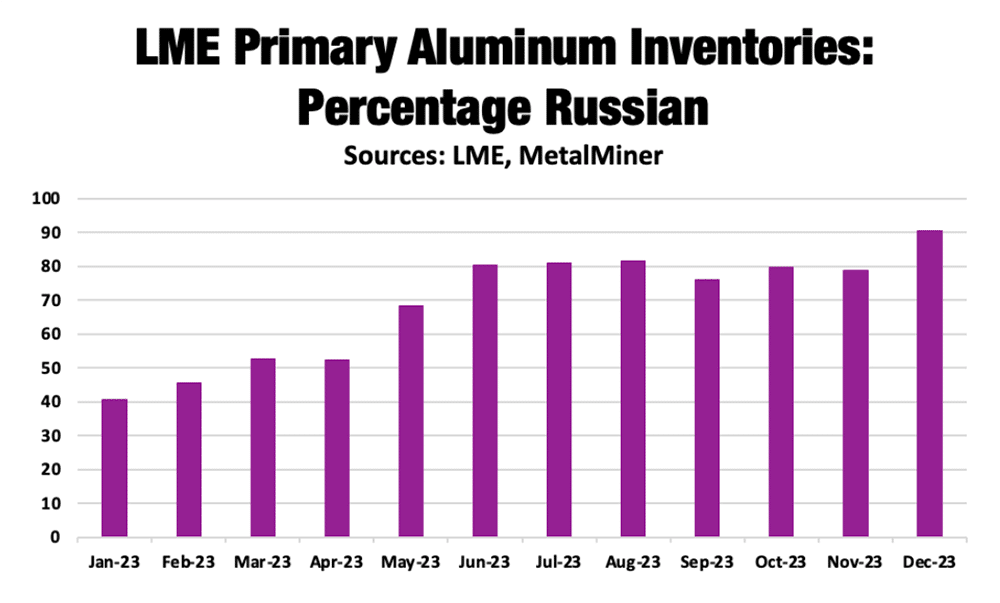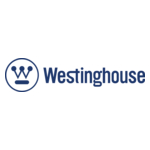Following a more than 8% month-over-month increase in December, aluminum prices retraced during the first weeks of January, returning to their sideways trend. Markets appeared to shake off alumina supply jitters that saw prices spike at the end of 2023, as global demand remains muted. Nonetheless, there remains no expert consensus as to the overall aluminum price forecast for 2024.
In total, the Aluminum Monthly Metals Index (MMI) rose 3.07% from December to January.
Gain access to expert-driven market insight, ensuring your company is well-informed and prepared to tackle falling demand. Opt into MetalMiner’s free weekly newsletter.
Russian Aluminum Surges to 90% of LME Stocks
The UK’s latest round of sanctions, which prohibited British citizens and companies from trading certain Russian metals, led to a spike in Russian-origin aluminum stocks. According to the LME’s Country of Origin reports, Russian primary aluminum stocks more than doubled in December, increasing roughly 118%.
Amid a draw-down in Indian-origin aluminum, Russian stocks accounted for 90.41% of total LME aluminum inventories, a new record high. As part of its transparency pledge, the LME began publishing Country of Origin data in January 2023. Indeed, escalating sanctions on Russian metals have led to a significant uptick in those metals sitting in LME warehouses throughout the year. At the start of last year, Russian aluminum stocks were just short of 41%, less than half today’s figures.

Indian-origin aluminum stood at 122,850 metric tons, representing over 53% of LME stocks. By December 2023, that level plummeted to 32,950 metric tons, accounting for just under 9% of total stocks. Such changes in the LME continue to cause problems for organizations scrambling to compile an aluminum price forecast for the rest of 2024.
Aluminum Price Forecast: The Risks to the LME Aluminum Contract
While widely espoused, the risks associated with a build-up of Russian-origin stocks on the LME have yet to come to fruition. Following the LME’s decision to continually admit Russian metals into its warehouses, market participants pointed to the possibility that LME prices would begin to reflect that of discounted Russian material. As they saw it, this would challenge its use as a global benchmark.
In July 2023, Norsk Hydro estimated that Russian-origin aluminum stood at a $100-300 per metric ton discount to metal produced elsewhere. But despite Russia’s growing dominance within LME inventories, the LME contract has yet to meaningfully diverge from other exchanges like the CME. In fact, as of January 12, LME prices held a modest premium over CME prices, while the almost perfect correlation between the two price points remained intact.
That said, others expressed opposite concerns. In a recent analysis, Amalgamated Metal Trading (AMT) forecasted aluminum prices to trend higher on the exchange due, in part, to the increasing number of sanctions on Russian aluminum. The article noted that moves by the UK and others could discourage “traders from holding/transporting metal and making short speculation increasingly risky. Given this backdrop, prices are likely to trend higher this year.”
Visually see where 2024 aluminum costs are projected to land with MetalMiner Insights’ comprehensive short and long-term price forecasts. Chat with us.
Global Premiums Show Short-Term Divergence
As markets wait to see what impact, if any, the latest sanctions will have on the LME contract, aluminum prices remain within a long-term sideways trend. However, global premiums, a proxy for regional demand, continue to diverge in the short term.
Europe’s duty unpaid aluminum premium closed 2023 with a modest rebound. The premium dropped to its lowest level since February 2021 during the first half of December, followed by a more than 23% rebound to its early January position. There is no way to tell whether the premium will sustain an uptrend, but it appears to have found at least a temporary bottom.
Meanwhile, the Midwest premium continued to trend sideways in early January, suggesting a meaningful turnaround in otherwise muted domestic demand. The premium saw an end-of-year spike alongside aluminum prices, which most experts attribute to concern over raw material supply in Guinea and China. However, like aluminum prices, the Midwest premium retraced back within range of its lowest level since March 2021.
The quarterly Main Japanese Port premium (MJP) appears increasingly bearish for Q1 2024. Japan stands as Asia’s largest import market, which makes the premium a significant benchmark for regional demand. Reports suggest buyers pressured the premium down to $90/mt, which reflects a nearly 7% drop from Q4 2023. Such bearish demand conditions in Asia will offer no support to global aluminum prices. According to the Japan Aluminum Association, November 2023 saw a 5.1% year-over-year decline in aluminum sheet and extrusion shipments, marking the 12th consecutive monthly decline.
Tired of inaccurate aluminum price forecasting, resulting in loss of revenue? The Monthly Metals Outlook report provides both short-term and long-term forecasts for aluminum, giving you the edge to navigate market volatility. Secure a free sample report.
Biggest Aluminum Price Moves
- LME primary three month aluminum prices saw the largest increase of the overall index, with a 8.37% jump to $2,382 per metric ton as of January 1.
- European commercial 1050 aluminum sheet prices increased by 6.56% to $3,221 per metric ton.
- Indian primary cash aluminum prices rose 4.65% to $2.57 per kilogram.
- Meanwhile, Korean commercial 1050 aluminum sheet prices moved sideways, declining by a modest 1.98% to $3.77 per kilogram.
- European 5083 aluminum plate prices saw a 2.41% decline to $5,117 per metric ton.




